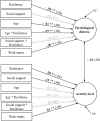Relationship between Resilience, Psychological Distress and Physical Activity in Cancer Patients: A Cross-Sectional Observation Study
- PMID: 27124466
- PMCID: PMC4849643
- DOI: 10.1371/journal.pone.0154496
Relationship between Resilience, Psychological Distress and Physical Activity in Cancer Patients: A Cross-Sectional Observation Study
Abstract
Objective: Psychological distress remains a major challenge in cancer care. The complexity of psychological symptoms in cancer patients requires multifaceted symptom management tailored to individual patient characteristics and active patient involvement. We assessed the relationship between resilience, psychological distress and physical activity in cancer patients to elucidate potential moderators of the identified relationships.
Method: A cross-sectional observational study to assess the prevalence of symptoms and supportive care needs of oncology patients undergoing chemotherapy, radiotherapy or chemo-radiation therapy in a tertiary oncology service. Resilience was assessed using the 10-item Connor-Davidson Resilience Scale (CD-RISC 10), social support was evaluated using the 12-item Multidimensional Scale of Perceived Social Support (MSPSS) and both psychological distress and activity level were measured using corresponding subscales of the Rotterdam Symptom Checklist (RSCL). Socio-demographic and medical data were extracted from patient medical records. Correlation analyses were performed and structural equation modeling was employed to assess the associations between resilience, psychological distress and activity level as well as selected socio-demographic variables.
Results: Data from 343 patients were included in the analysis. Our revised model demonstrated an acceptable fit to the data (χ2(163) = 313.76, p = .000, comparative fit index (CFI) = .942, Tucker-Lewis index (TLI) = .923, root mean square error of approximation (RMSEA) = .053, 90% CI [.044.062]). Resilience was negatively associated with psychological distress (β = -.59), and positively associated with activity level (β = .20). The relationship between resilience and psychological distress was moderated by age (β = -0.33) but not social support (β = .10, p = .12).
Conclusion: Cancer patients with higher resilience, particularly older patients, experience lower psychological distress. Patients with higher resilience are physically more active. Evaluating levels of resilience in cancer patients then tailoring targeted interventions to facilitate resilience may help improve the effectiveness of psychological symptom management interventions.
Conflict of interest statement
Figures



Similar articles
-
A Structural Equation Model of the Relationship Between Symptom Burden, Psychological Resilience, Coping Styles, Social Support, and Psychological Distress in Elderly Patients With Acute Exacerbation Chronic Obstructive Pulmonary Disease in China.Asian Nurs Res (Korean Soc Nurs Sci). 2024 Aug;18(3):231-237. doi: 10.1016/j.anr.2024.06.003. Epub 2024 Jun 21. Asian Nurs Res (Korean Soc Nurs Sci). 2024. PMID: 38908429
-
Validation and application of the Chinese version of the 10-item Connor-Davidson Resilience Scale (CD-RISC-10) among parents of children with cancer diagnosis.Eur J Oncol Nurs. 2017 Apr;27:36-44. doi: 10.1016/j.ejon.2017.01.004. Epub 2017 Feb 12. Eur J Oncol Nurs. 2017. PMID: 28279394
-
Prevalence of psychological distress and the effects of resilience and perceived social support among Chinese college students: Does gender make a difference?Psychiatry Res. 2018 Sep;267:409-413. doi: 10.1016/j.psychres.2018.06.038. Epub 2018 Jun 20. Psychiatry Res. 2018. PMID: 29960938
-
Behavioural modification interventions for medically unexplained symptoms in primary care: systematic reviews and economic evaluation.Health Technol Assess. 2020 Sep;24(46):1-490. doi: 10.3310/hta24460. Health Technol Assess. 2020. PMID: 32975190 Free PMC article.
-
Family Resilience in Adult Oncology: A Systematic Review and Meta-Analysis.Oncol Nurs Forum. 2025 Apr 23;52(3):228-240. doi: 10.1188/25.ONF.228-240. Oncol Nurs Forum. 2025. PMID: 40293936 Free PMC article.
Cited by
-
The effect of exercise on resilience, its mediators and moderators, in a general population during the UK COVID-19 pandemic in 2020: a cross-sectional online study.BMC Public Health. 2022 Apr 25;22(1):827. doi: 10.1186/s12889-022-13070-7. BMC Public Health. 2022. PMID: 35468747 Free PMC article.
-
Reliability and validity of the Chinese version of the Family Resilience Questionnaire (FaRE Questionnaire) in patients with breast cancer: a cross-sectional study.BMJ Open. 2022 Apr 20;12(4):e051093. doi: 10.1136/bmjopen-2021-051093. BMJ Open. 2022. PMID: 35443942 Free PMC article.
-
Factors associated with muscle function in patients with hematologic malignancies undergoing chemotherapy.Support Care Cancer. 2020 Mar;28(3):1433-1439. doi: 10.1007/s00520-019-04955-2. Epub 2019 Jul 3. Support Care Cancer. 2020. PMID: 31267281
-
Translation and population-based validation of the Arabic version of the brief resilience scale.Ann Med. 2023 Dec;55(1):2230887. doi: 10.1080/07853890.2023.2230887. Ann Med. 2023. PMID: 37395119 Free PMC article.
-
The Interplay of Chronic Stress and Cancer: Pathophysiology and Implications for Integrated Care.Cancer Rep (Hoboken). 2025 May;8(5):e70143. doi: 10.1002/cnr2.70143. Cancer Rep (Hoboken). 2025. PMID: 40387308 Free PMC article. Review.
References
-
- Kroenke K, Johns SA, Theobald D, Wu J, Tu W. Somatic symptoms in cancer patients trajectory over 12 months and impact on functional status and disability. Supportive care in cancer: official journal of the Multinational Association of Supportive Care in Cancer. 2013. March;21(3):765–73. - PMC - PubMed
-
- Cleeland CS. Symptom burden: multiple symptoms and their impact as patient-reported outcomes. J Natl Cancer Inst Monogr. 2007. (37):16–21. - PubMed
Publication types
MeSH terms
LinkOut - more resources
Full Text Sources
Other Literature Sources
Medical
Miscellaneous

